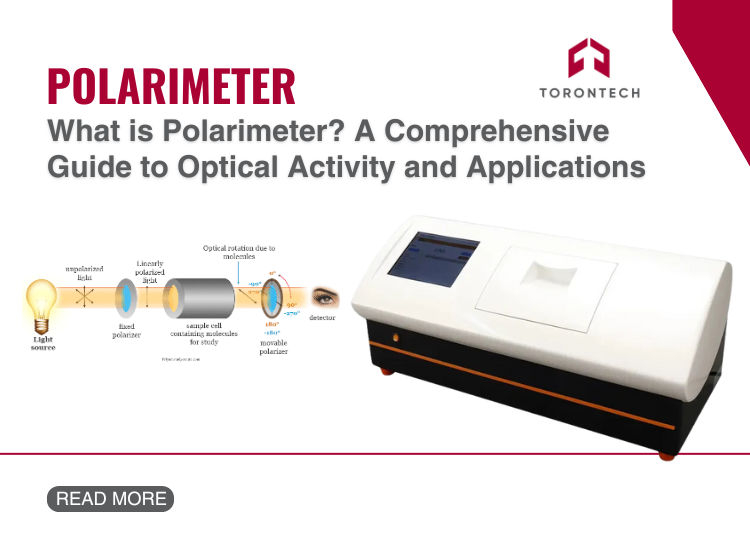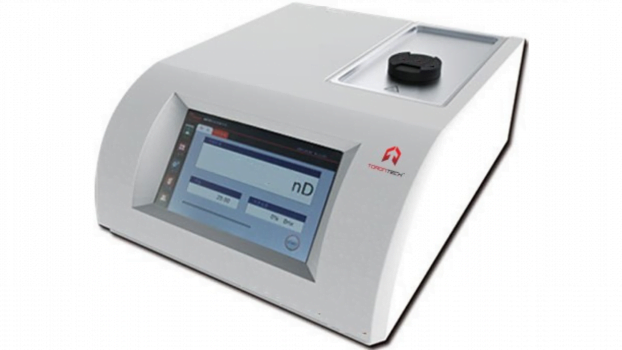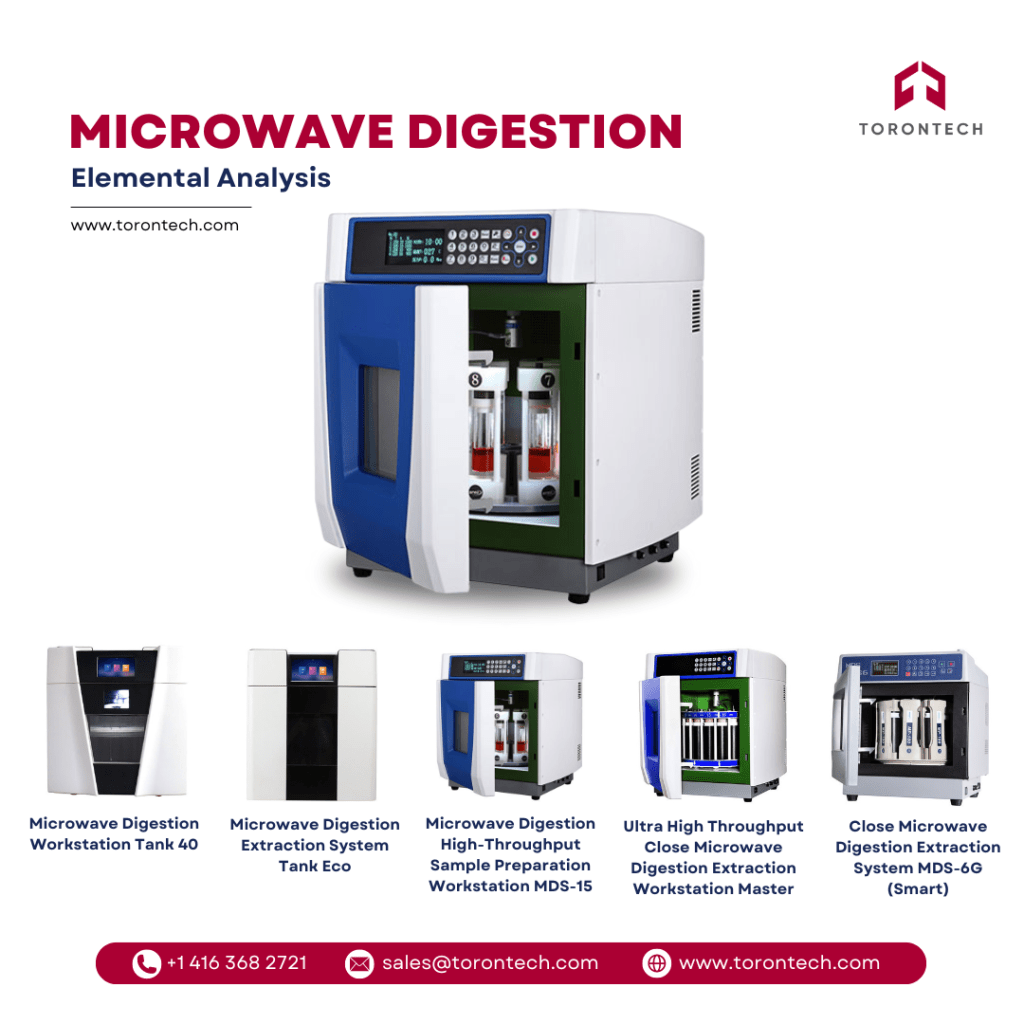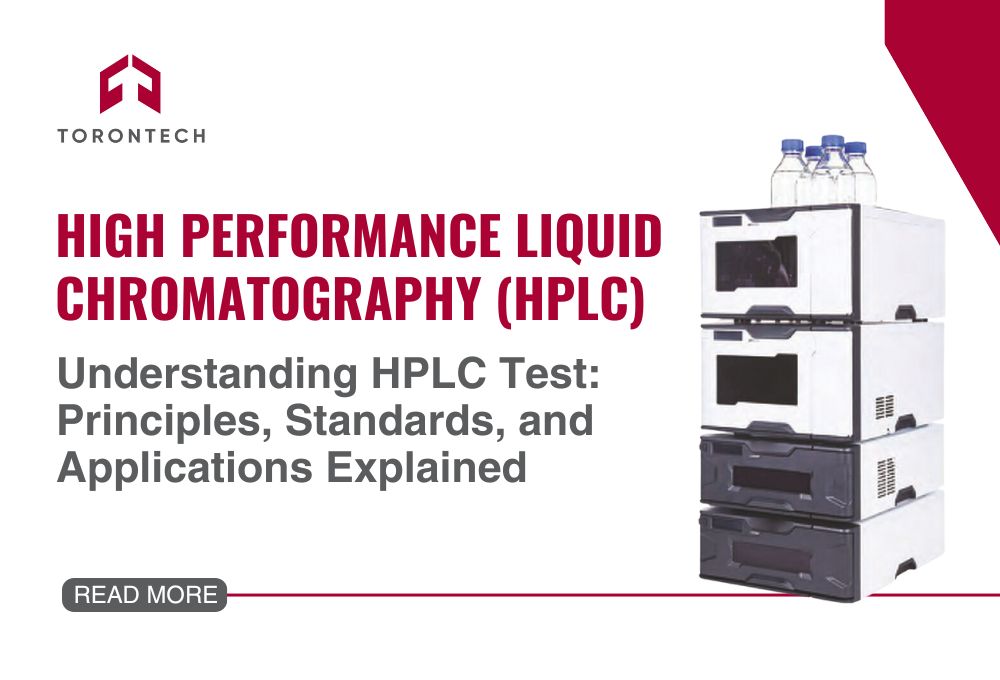Struggling to ensure the purity of your solutions or verify optical properties accurately? Without the right tool, it’s easy to waste time and risk inconsistent results in your analysis.
A polarimeter solves this by offering precise measurements of optical rotation, helping you analyze substances like sugar solutions and chemicals with confidence.
Let’s explore how it works, its principle, and how it can elevate your processes.
What is a Polarimeter?
A polarimeter is a scientific instrument designed to measure the optical rotation of polarized light as it passes through optically active substances. Simply put, it helps you understand how specific materials, like sugar solutions or chemical compounds, interact with light.
When polarized light interacts with an optically active sample, the angle of rotation changes. This change -called the angle of rotation in polarimeter readings- provides critical insights into the substance’s concentration, purity, or molecular structure. With applications ranging from chemistry to pharmaceuticals and food industries, polarimeters are a cornerstone for precise optical measurements.
Principle of a Polarimeter
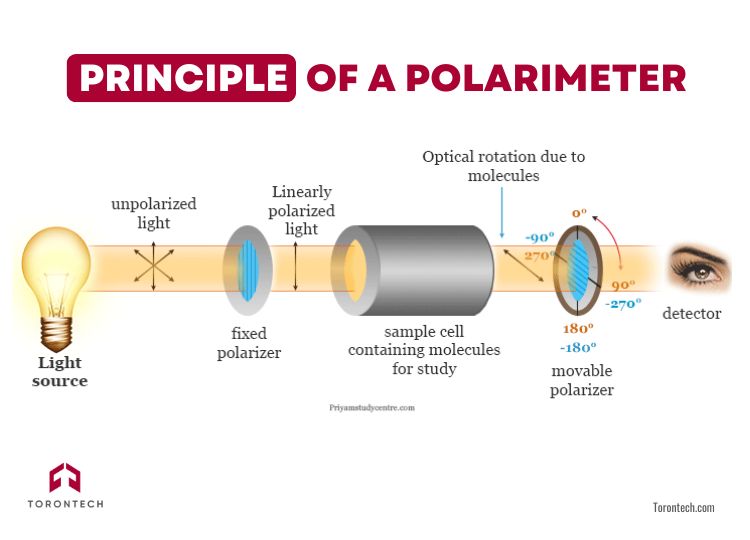
The working principle of a polarimeter lies in the interaction between polarized light and an optically active substance. When polarized light passes through a sample, the molecules of the substance rotate the plane of polarization. This rotation, known as optical rotation, depends on the sample’s nature, concentration, and the length of the path the light travels through.
The polarimeter principle uses a light source, polarizer, sample tube, and analyzer. The polarizer converts ordinary light into polarized light, which is then directed through the sample. The analyzer measures the angle by which the light’s plane has been rotated.
This angle of rotation in polarimeter readings can be mathematically calculated using the polarimeter equation to determine the substance’s properties, such as its concentration or optical activity.
Understanding this principle is key to using a polarimeter effectively, whether in routine quality control or advanced chemical analysis. Let’s move forward to see how this fascinating instrument works in practice.
How Does a Polarimeter Work?
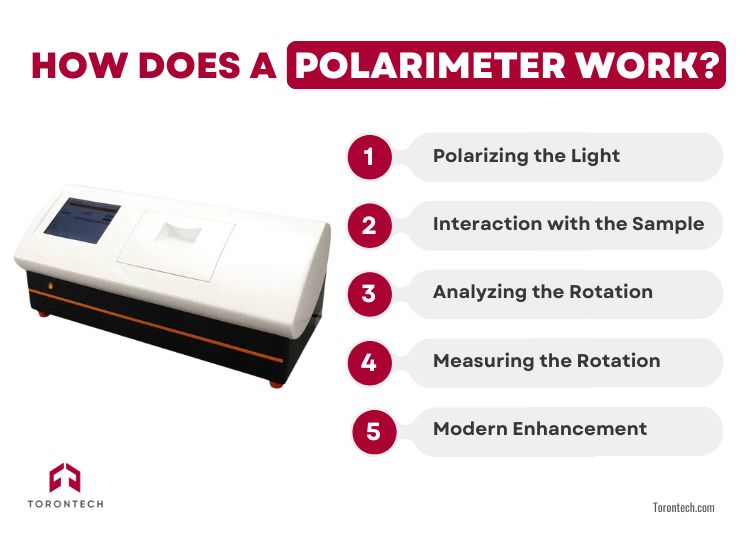
A polarimeter functions by leveraging polarized light to measure the optical rotation caused by an optically active substance. The process involves carefully manipulating light and observing how it interacts with the sample. Here’s how it works, step-by-step:
1. Polarizing the Light
The light source, typically unpolarized, is passed through a polarizer to create a linear polarization state. This step ensures the light entering the sample is uniformly polarized for accurate measurements.
2. Interaction with the Sample
The polarized light travels through a sample tube containing the optically active substance. As the light interacts with the sample, its polarization direction rotates based on the substance’s concentration and optical activity.
3. Analyzing the Rotation
After passing through the sample, the light reaches a second polarizer, known as the analyzer, which is adjustable. The analyzer is rotated until it blocks the transmission of light entirely, creating a condition of zero transmission. This occurs when the transmission axes of the polarizer and analyzer are at right angles.
4. Measuring the Rotation
If the sample is optically active, the analyzer must be rotated further to reach the zero transmission condition. The degree of rotation needed to restore the original dark condition is noted. This difference gives the angle of rotation, providing insights into the sample’s optical properties.
5. Modern Enhancement
In advanced digital polarimeters and automatic polarimeters, this process is automated. Lasers or electronic sensors detect the changes in polarization, and the results are instantly displayed on a digital screen for quick and accurate readings.
This systematic method ensures precise measurements, whether you’re working with a manual polarimeter or a sophisticated machine. With a deeper understanding of this process, you can maximize the reliability of your optical rotation analysis.
Types of Polarimeters
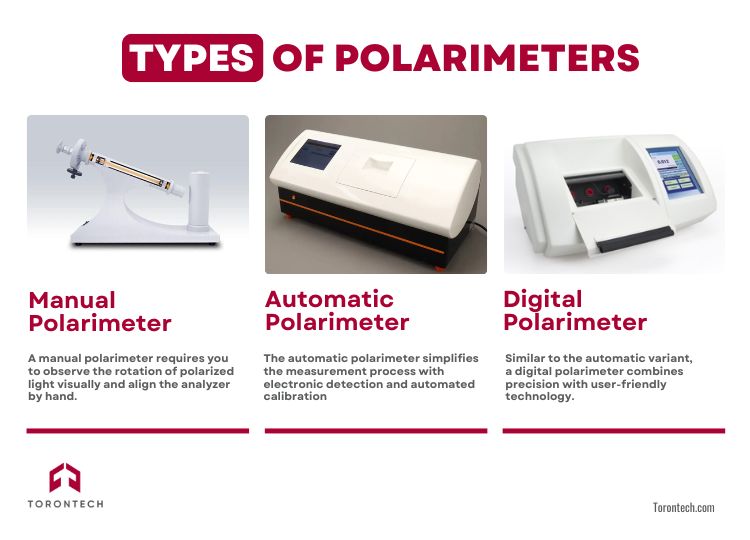
Polarimeters come in various types, each designed to meet specific analytical needs. Whether you’re conducting basic experiments or handling advanced industrial applications, understanding these types helps you choose the right instrument for your work.
1. Manual Polarimeter
A manual polarimeter requires you to observe the rotation of polarized light visually and align the analyzer by hand. While affordable and straightforward, it demands precision and is best suited for educational purposes or basic laboratory tasks.
2. Automatic Polarimeter
The automatic polarimeter simplifies the measurement process with electronic detection and automated calibration. Equipped with digital screens, these instruments provide instant, accurate results, making them ideal for industries requiring high throughput and reliability.
3. Digital Polarimeter
Similar to the automatic variant, a digital polarimeter combines precision with user-friendly technology. It often features advanced software, data storage, and connectivity options, ensuring seamless integration into modern laboratory workflows.
When selecting a polarimeter, consider the sample types, accuracy requirements, and workflow demands. Each type addresses unique challenges, ensuring reliable measurements for your specific application.
How to Use a Polarimeter
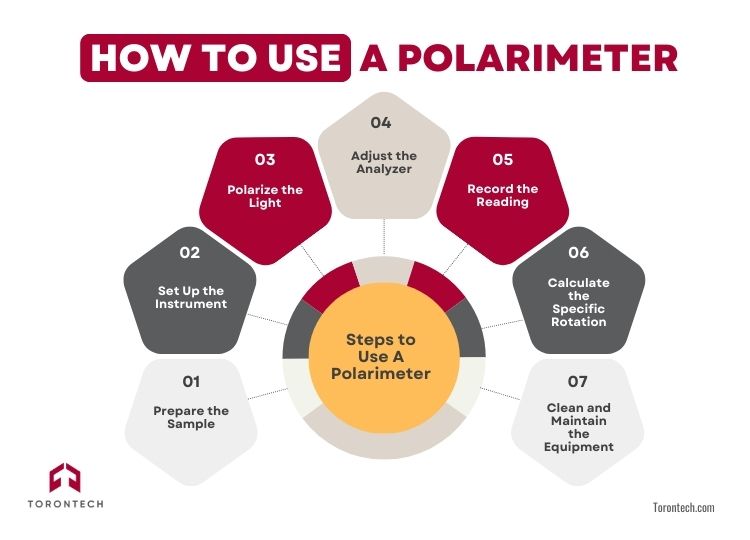
Using a polarimeter effectively requires attention to detail to ensure accurate and repeatable results. Whether you’re working with a manual, digital, or automatic polarimeter, the steps remain fundamentally the same. Step-by-Step Guide:
1. Prepare the Sample
- Ensure the sample is optically active and free from impurities.
- Fill the sample tube with the solution, ensuring there are no air bubbles, as these can distort the measurement.
2. Set Up the Instrument
- Turn on the polarimeter and allow it to stabilize if necessary.
- Insert the sample tube into the instrument, ensuring it is properly aligned.
3. Polarize the Light
The polarimeter’s light source produces unpolarized light, which is then passed through a polarizer to create a linear polarization state.
4. Adjust the Analyzer
- For a manual polarimeter, rotate the analyzer until the transmission of light is minimized or the dark condition is restored.
- In automatic polarimeters, this process is handled electronically, and the results are displayed on a digital screen.
5. Record the Reading
- Note the initial reading (without the sample) and the final reading (with the sample).
- The difference between these readings gives the angle of rotation, which indicates the optical activity of the sample.
6. Calculate the Specific Rotation
Use the polarimeter formula to determine the specific rotation (α). For the automatic and digital polarimeter, you might get this data instant. But for manual polarimeter, somitimes you must use the formula in the next chapter give to yoou to calculate.
7. Clean and Maintain the Equipment
After completing the measurement, clean the sample tube and other components to prevent residue build-up.
By following these steps, you ensure accurate and reliable measurements, whether analyzing sugar solutions, chemicals, or pharmaceutical samples.
Applications of Polarimeters
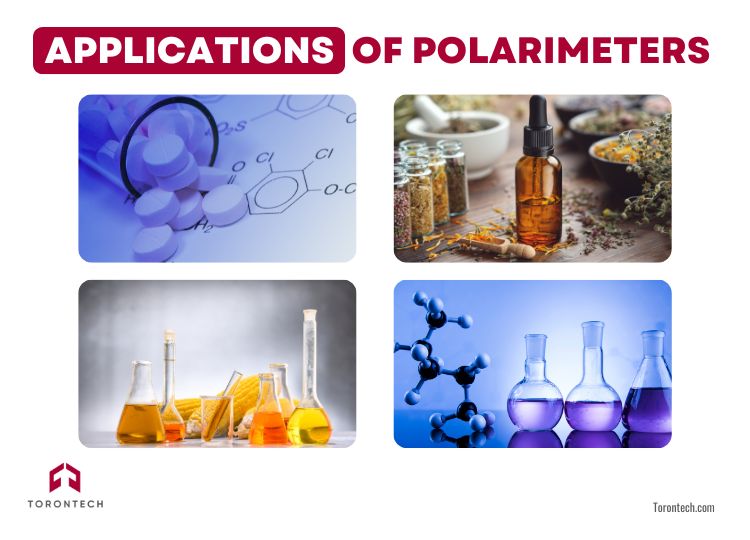
Polarimeters play a crucial role in both research and quality control, providing indispensable insights into the optical properties of substances. From isolating unknown compounds to ensuring product purity, these instruments are integral to diverse industries and academic fields.
A. Research Applications
In research, polarimeters are widely used for exploring optical activity. For instance, Marshal Soni (2019) highlights how polarimetry enables the measurement of optical activity, focusing on design considerations and automation techniques in modern instruments. This is particularly useful in applications like isolating unknown compounds or monitoring enzymatic reactions.
Additionally, innovative approaches to polarimeter design, such as the laser heterodyne polarimeter introduced by Harold Hollis et al. (2017), enable sub-microradian precision for birefringence measurements. This advancement is critical in fields requiring high sensitivity and precision.
Below is key uses Polarimeters in research field:
1. Isolating and Identifying Unknowns
Polarimeters help identify unknown compounds crystallized from various solvents or separated by high-performance liquid chromatography (HPLC).
2. Monitoring Kinetic Reactions
By measuring optical rotation over time, researchers can track changes in the concentration of optically active components, such as during enzymatic reactions.
3. Molecular Structure Analysis
Polarimeters allow researchers to analyze molecular structures by plotting optical rotatory dispersion curves over a wide wavelength range.
4. Distinguishing Optical Isomers
The ability to differentiate between enantiomers is crucial, particularly in fields like pharmaceuticals, where the efficacy and safety of drugs can depend on their chiral form.
5. Chiral Molecule Analysis
Polarimetry is fundamental in identifying and characterizing chiral molecules, which are pivotal in drug development and biochemical research.
B. Quality and Process Control Applications
Polarimeters are equally vital in quality assurance and process control, ensuring consistency and compliance across industries:
1. Pharmaceutical Industry
In the pharmaceutical industry, polarimeters are essential for testing the purity of compounds. As noted by James Hough (2006), polarimetry’s diagnostic capabilities extend beyond standard laboratory applications, offering insights into material properties that ensure compliance with stringent quality standards.
Polarimeters also measure specific rotation and optical rotation to verify the purity of amino acids, antibiotics, tranquilizers, and other compounds. Testing often uses 589 nm light (sodium D line), with modern polarimeters achieving an accuracy of up to 0.01°.
2. Flavor, Fragrance, and Essential Oils
Inspection of raw materials such as camphors, gums, natural acids, and oils ensures the quality of incoming products and helps maintain high standards.
3. Food Industry
The food and beverage industry also benefits significantly from polarimetry. Polarimeters ensure the quality and concentration of sugars in products like syrups and cereals, a process thoroughly reviewed by Lingying Chang et al. (2023) in their evaluation of advanced measurement schemes.
Polarimeters also used to assess the concentration and purity of carbohydrates, sucrose, glucose, fructose, and starches in sugar-based foods, ensuring product quality.
4. Chemical Industry
Optical rotation analysis aids in identifying and characterizing natural, synthetic, and biopolymers. This helps in ensuring product integrity and meeting specific standards.
Polarimeter Formula and Calculations
Polarimeters rely on specific formulas to quantify optical rotation and extract meaningful data about a substance. These calculations are central to understanding the optical properties of your samples and ensuring accurate measurements.
The Polarimeter Formula
The relationship between optical rotation and a substance’s properties is defined by the specific rotation formula:
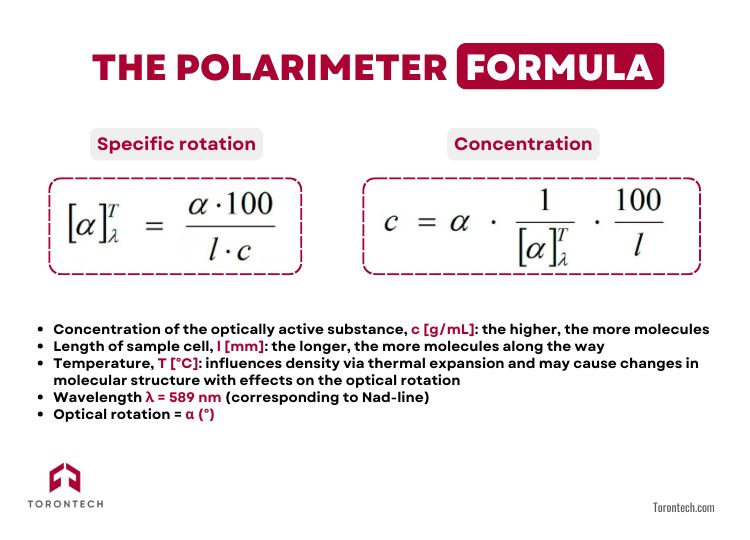
This formula is essential when comparing results across different laboratories or sample conditions, ensuring consistency in evaluations.
Calculating Specific Rotation
- Measure the Angle of Rotation: Use the polarimeter to find the rotation angle (α) of the polarized light after passing through the sample.
- Determine Path Length: Measure the length of the sample tube, typically ranging from 10 to 20 cm (1 to 2 dm).
- Prepare the Sample: Calculate the concentration (c) by dividing the solute’s weight by the solvent’s volume.
- Apply the Formula: Substitute the values into the equation to calculate the specific rotation.
Practical Applications of the Formula
- Pharmaceutical Testing: Verify drug purity by calculating the specific rotation of active pharmaceutical ingredients (APIs).
- Sugar Industry: Measure the concentration of sucrose or glucose in solutions.
- Chemical Analysis: Identify unknown compounds based on their unique optical rotation values.
Final Thoughts
A polarimeter is more than just an instrument; it’s a gateway to understanding optical activity with precision and reliability. From research applications like analyzing chiral molecules to quality control in industries such as pharmaceuticals, food, and chemicals, polarimeters have become indispensable tools.
Whether you’re working with a manual polarimeter or leveraging the efficiency of a digital or automatic polarimeter, understanding its principles and formulas ensures you get the most out of your device. Accurate measurements of optical rotation are essential for achieving consistent quality, maintaining compliance, and driving innovation in your field.
As you apply this knowledge, remember that choosing the right polarimeter for your needs and following best practices for its use and maintenance will unlock its full potential, empowering you to achieve your goals with confidence.
Frequently Asked Question (FAQ)
2. For our pharmaceutical operations, how critical is a polarimeter for regulatory compliance?
In the pharmaceutical industry, a polarimeter is essential for meeting regulatory requirements set by pharmacopeias like the USP. It is used to measure the specific rotation of active pharmaceutical ingredients (APIs), amino acids, and antibiotics to confirm their identity, purity, and concentration. Using a precise, compliant instrument, such as the automatic polarimeters offered by Torontech, provides the accurate and auditable data required for regulatory submissions and batch release documentation.
3. We have a high sample throughput. What are the business advantages of an automatic polarimeter?
For labs with a high workload, an automatic polarimeter offers significant advantages over manual models. It eliminates subjective user interpretation, drastically reduces measurement time, and improves accuracy and repeatability. Features like digital readouts, data logging, and automated calibration streamline workflows and create reliable audit trails for compliance. Investing in an automatic system from a trusted provider like Torontech directly translates to increased lab productivity and more reliable quality control.
4. How can a polarimeter streamline our production process in the food and beverage industry?
In the food and beverage sector, a polarimeter is key for process control, particularly in sugar-based production. It allows for rapid and accurate measurement of sugar concentrations in syrups, juices, and other ingredients, ensuring product consistency from batch to batch. This real-time data enables immediate adjustments to the production process, helping maintain quality standards and optimize raw material usage efficiently.
5. What factors ensure we get accurate and reliable measurements from our polarimeter for QA?
Reliable results depend on both proper procedure and high-quality equipment. Key procedural steps include careful sample preparation to eliminate impurities and air bubbles, and maintaining a stable instrument temperature. Fundamentally, the accuracy stems from the instrument itself. Partnering with a supplier like Torontech ensures you acquire a robust, precision-engineered polarimeter designed to provide the consistent and accurate measurements essential for a stringent quality assurance program.
References:
- Hough, J. (2006). Polarimetry: A powerful diagnostic tool in astronomy. Astronomy & Geophysics, 47(4), 4.34–4.41. https://doi.org/10.1111/j.1468-4004.2006.47434.x
- Soni, M. (2019). A review on the measurement of optical activity by using a polarimeter. Journal of Pharmacognosy and Phytochemistry, 8(3), 375-379. https://phytojournal.com/
- Hollis, H., Mitchell, M., & Wheatley, J. (2017). A laser heterodyne polarimeter for birefringence measurement. arXiv. https://arxiv.org/abs/1702.08476
- Chang, L., Zhang, Y., & Chen, F. (2023). LCVR-based Stokes polarimeter: Principles and evaluation. In Proceedings of the Third International Computing Imaging Conference (CITA). SPIE Digital Library.

